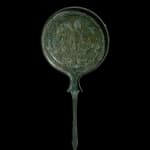Etruscan
Further images
Provenance
With Elie Borowski, Basel, 1952Fridolin (1903 - 1969) and Halina (1907 - 1989) Schwitter-Lagutt Collection, Basel, Switzerland, acquired from the above, thence by descent
Christie’s, London, 5 July 2017, lot 171
Private collection, Germany, acquired from the above
Fridolin Schwitter-Lagutt was the founder of Schwitter AG (Clichéanstalt) in Basel, a printer specialised in fine art books, posters, and scientific illustrations, which he grew to international success. He shared a deep passion for art with his wife Halina, and together they started collecting in a wide variety of fields, such as Antiquities, Asian, and Pre-Columbian art. Through their work they became close friends with a number of prominent Swiss, Austrian, and German artists of the time including Oskar Kokoschka, Walter Kurt Wiemken, and painter and archaeologist Fritz Pümpin. The Schwitter-Lagutts built a large collection of several hundred ancient objects, including the Glienicke Athena.
Literature
Mirrors, known to the Etruscans as malena or malstria, were first produced from the end of the 6th century BC right through to the 2nd century BC. They were locally made in towns such as Vulci, Tarquinia, Cerveteri, and Chiusi. Their integral importance within Etruscan daily life is demonstrated by the number of mirrors that have been discovered. These mirrors must not be seen as mere tomb furniture placed in graves to prove the deceased's social status, but as highly symbolic objects important to their owners during their lifetimes and after their death.The range of subjects include scenes from everyday life, especially, toilet-scenes and courting-scenes; although many of these scenes in fact feature Greek divinities or heroes and heroines, and especially popular were Aphrodite and Adonis, and Helen and Paris (or Menelaos). The prevalence of Hellenistic subject matter clearly demonstrates the great influence of Greek heroic myth and legend on Etruscan visual culture.
Etruscan bronze mirrors, like Greek examples, were designed to be held in the hand using a single handle. The reflective side of the mirrors was made by highly polishing or silvering the surface. From the 3rd century BC more tin was used in the bronze alloy, which meant that the reflective surface gave a clearer image, and was less prone to scratching and corrosion.
This mirror belongs to the group of so-called wreath-mirrors. The type usually depicts three or four figures in scenes which can be challenging to identify. However, scenes featuring the Dioskouroi and their sister Helen were a popular theme on Etruscan mirrors. For mirrors with similarly finely engraved scenes see, E. Gärtner, Etruskische Spiegel, Dritter Theil, Berlin, 1863, pp. 394 - 419; Pl. CCLXVIII - CCLXXVIII. See also, A. de Ridder, Les Bronzes Antiques du Louvre, Paris, 1913, vol.II p.58, inv.1782.









